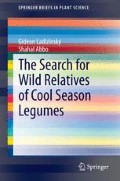Abstract
The genus Lens comprises the following species: L. culinaris with two subspecies: ssp. culinaris (the domesticated lentil) and ssp. orientalis (the wild form of ssp. culinaris), L. tomentosus, L. odemensis, L. ervoides, L. nigricans, and L. lamottei. Each of these species has its own morphological characteristics and shows specific ecological affinities and typical geographic distribution. Furthermore, they are reproductively isolated from one another by cross-incompatibility or by hybrid sterility. Chromosomically ssp. orientalis is the most variable of all the Lens taxa, as indicated by the occurrence of multivalent formations at meiosis or of bridges and fragments in intra-taxon hybrids. Lens culinaris and particularly its wild form comprise several crossability groups, one of which includes the domesticated lentil and most of its wild-form accessions. Based on characteristics that are monomorphic in ssp. culinaris but variable in ssp. orientalis, it was proposed that the wild genetic stock that gave rise to the domesticated lentil was the one of ssp. orientalis that shared them with the domesticated form. These characteristics are chromosome arrangement, crossability potential, and pattern of restriction-enzyme recognition sites of chloroplast DNA (cpDNA). Populations of ssp. orientalis possessing these characteristics were detected in northern Syria and southern Turkey. The effective wild gene pool of the cultigens includes members of ssp. orientalis, L. odemensis, L. tomentosus, and L. ervoides, the last two species can be exploited only by hybrid embryo rescue techniques.
Lentil is considered to be one of the oldest legumes used by humans, as attested by the remains of lentil seeds found in archaeological diggings as old as 10,000 years. Our findings indicate that lentil seeds formed only a negligible part of the pre-Neolithic diet. In nature, plants of ssp. orientalis grow in sparse stands and produce on average about 10 seeds per plant. To obtain 1 kg of wild lentil seeds, about 10,000 plants must be collected—not an attractive option in terms of input and output. Furthermore, because of seed-coat impermeability to water, only about 10 % of seed collected in spring will germinate in the following winter. As each of the resultant plants will produce 10 seeds, the expected yield is similar to the quantity of seeds sown. With regard to the question of how lentil cultivation began, it has been suggested that a germination-free mutant evolved in a natural stand of ssp. orientalis, resulting in the formation of a massive stand that attracted food gatherers, and when seeds collected from such populations were used in sowing experiments the yield was high enough for lentil cultivation to be continued.
Access this chapter
Tax calculation will be finalised at checkout
Purchases are for personal use only
Author information
Authors and Affiliations
Corresponding author
Rights and permissions
Copyright information
© 2015 Springer International Publishing Switzerland
About this chapter
Cite this chapter
Ladizinsky, G., Abbo, S. (2015). The Lens Genus. In: The Search for Wild Relatives of Cool Season Legumes. SpringerBriefs in Plant Science. Springer, Cham. https://doi.org/10.1007/978-3-319-14505-1_1
Download citation
DOI: https://doi.org/10.1007/978-3-319-14505-1_1
Published:
Publisher Name: Springer, Cham
Print ISBN: 978-3-319-14504-4
Online ISBN: 978-3-319-14505-1
eBook Packages: Biomedical and Life SciencesBiomedical and Life Sciences (R0)

